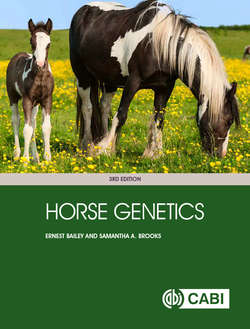Читать книгу Horse Genetics - Ernest Bailey - Страница 10
Genetic Relationships Among Breeds
ОглавлениеWe cannot use a single genetic trait to identify the breed of a horse. There are no Arabian horse genes or Thoroughbred horse genes. We may think of dish-faces as an Arabian horse trait, but if we look at enough horses in any large population we will find a horse with a dish-face. However, if we look at a field of horses and see lots of gray horses with dish-faces, we are going to think Arabian horse. While individual genes in a single horse do not characterize a breed, their prevalence in a population is characteristic of a breed. This is true with any genetic variant.
Consider the gene for albumin. Studies in the 1960s led to the identification of two biochemical forms, A and B. We can test herds of horses of different breeds for albumin, then determine the frequency of the two forms. Table 1.1 shows the frequency of the two albumin alleles in 13 breeds of horse.
Table 1.1. Frequencies of the albumin gene alleles among 13 horse breeds.
| Breed | Frequency ALB-A | Frequency of ALB-B |
| Andalusian | 0.59 | 0.41 |
| Arabian | 0.43 | 0.57 |
| Belgian | 0.35 | 0.65 |
| Icelandic | 0.43 | 0.57 |
| Lipizzaner | 0.08 | 0.92 |
| Miniature | 0.27 | 0.73 |
| Norwegian Fjord | 0.34 | 0.66 |
| Paso Fino | 0.42 | 0.58 |
| Quarter horse | 0.28 | 0.72 |
| Shire | 0.45 | 0.55 |
| Standardbred | 0.59 | 0.41 |
| Tennessee Walking horse | 0.44 | 0.56 |
| Thoroughbred | 0.17 | 0.83 |
From this table you can see that both alleles of albumin are found in all breeds of horses. The presence of either or both alleles in an individual horse tells us nothing about the breed of the horse. However, if we were to find a pasture with 100 horses of the same breed, typed them for albumin, found a gene frequency for B of 0.45, we would reject the suggestion that the horses were Lipizzaner, Miniature horses or Thoroughbreds. The frequency of the B allele would be too high. Of course, we would also draw this conclusion from other observations, but the main point is that the gene frequencies for albumin alleles gives us evidence for and against the breed membership for a herd of horses. As we test a larger number of genes, our evidence becomes stronger. However, we have never found a gene which is characteristic of a breed. While horses of all breeds can have albumin allele A and albumin allele B, the frequency of the alleles in a population of horses provides a small bit of evidence for the breed of origin.
A single locus does not give us a lot of power to determine the breed of a population of horses. We need a lot of genetic markers to effectively distinguish between breeds. With the advent of DNA testing, we have millions of DNA variants to use in comparing horse populations. Another application of these genetic markers is to identify the genetic relationship among populations. The point is that closely related populations and breeds share more genetic characteristics than distantly related populations.
Through the efforts of collaborating scientists around the world, DNA markers were developed for the horse and have been used widely to compare horses. These studies have benefited greatly from the increased use of parentage testing by horse breed registries around the world and adoption of a common set of microsatellite DNA markers for routine testing.
The development of genetic markers based on single nucleotide polymorphisms (SNPs) of DNA (Chapters 4 and 6) provided greater resolution for investigations of relationships among horse breeds. Fig. 1.1 illustrates the results of analyses of genetic distance in 38 horse populations using 6028 SNP markers (Petersen et al., 2013).
Fig. 1.1. Majority rule, neighbor join tree created from 6028 SNP markers using Nei’s genetic distance and allele frequencies within each population. The percentage bootstrap support indicated on all branches was calculated from 1000 replicates. The approach creates a “family tree” of horse breeds where the length of the branches is proportional to the genetic distance between two populations. (Reprinted with permission from Petersen et al. 2013.)
Not all breeds or populations of horses appear on this tree. However, an effort was made to select horses from different parts of the world and with widely divergent breeding histories. Not surprising to students of horse breeds, the Arabian horse appears in the middle of the tree with the Thoroughbred breed at the opposite end from the pony breeds and draft horse breeds.
